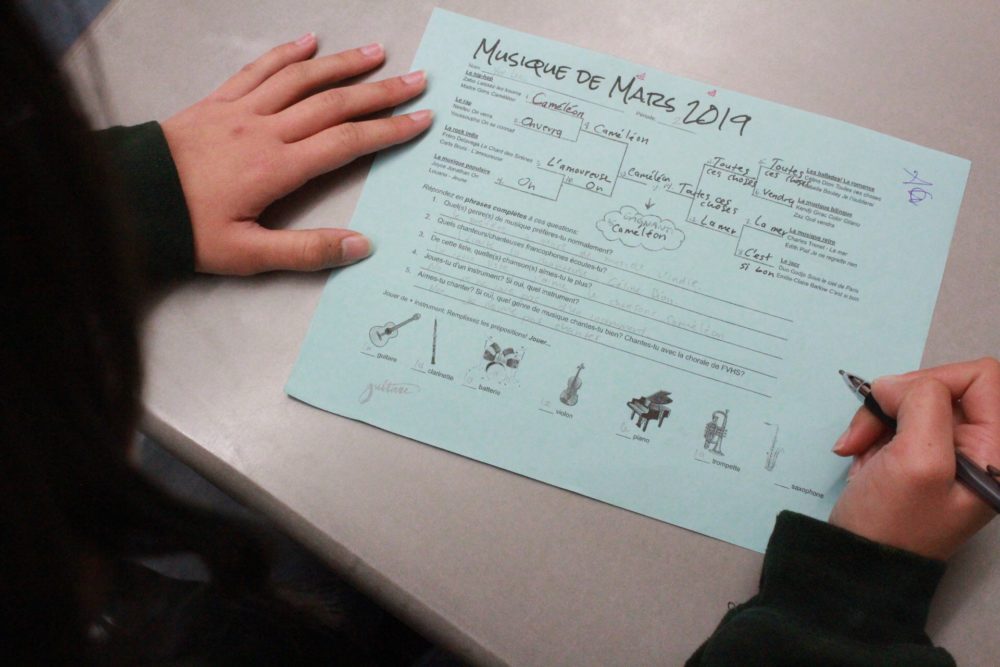
By Jennifer Trend, Staff Writer
In the spirit of college basketball’s March Madness, a few of the Spanish and French classes are running their own competition with songs in those languages. Though spanning much longer than the basketball March Madness, it still holds the spirit of competition.
Before voting, students are given a packet of 16 songs and a bracket system they fill out with their predictions of which song will be most popular among all the participating students. Every week since March 1, students have selected their favorite between two songs. This process repeats until the number of songs are cut in half and eventually the two most popular songs will go head-to-head the week before spring break.
Some teachers have chosen to dedicate class time to listen to the songs and do an activity surrounding it. For example, Spanish classwork may include creating sentences relating to the week’s songs. In their packets students get Spanish sentence starters such as “This song makes me feel…” or “I like this song because…” and may receive participation credit. Typically there is no homework other than to vote on a Google form after listening to the song if it is not done in class.
“In my classes it’s kind of something if it works out, I plan to do it on Friday as a ‘fun Friday’ kind of thing to do. It takes maybe about twenty minutes,” said World Language Department Head Jim Diecidue. “For the first round that we listened to the songs, students write down some observations—how they feel about the song, if they liked the rhythm or the instruments or the voice of the singer—different aspects of the songs that stand out, and then they talk about it in their groups, and we share it in class a little bit, some of our comments about the songs, and then we vote.”
In 2015, Diecidue found a blog where another Spanish teacher was doing this activity and shared it with a few other teachers. Since then, they’ve started and continued their own “March Madness”. Every year more teachers have joined, and the Spanish teachers come together to decide on a new list of songs.
“That’s one of the fun parts—putting together a list every year as the teachers that work together and just have a lot of fun putting together the list. We do change it because the fact that we use it at different levels and we don’t want a student going from Spanish three to four to repeat any of the same songs- we want it to be a different experience every time,” said Diecidue.
This year, instead of having just certain genres or popular songs, Spanish is focusing on music of a regional variety—songs from Spain, Mexico, the Caribbean and South America. For example, there are songs with flamenco influences from Spain, cumbia from Mexico, bachata from the Caribbean and salsa songs from Puerto Rico. French has the brackets ordered in genres, ranging from pop to ballads to indie music.
“I think that it is a really fun way for students to venture out in many aspects. This activity has introduced me to various French songs of many different genres that I wouldn’t have spent the time to explore on my own,” said junior Emilie Phan. “March Madness is a refreshing change from the usual textbook lesson and is still a beneficial learning experience.”
As of now, the Spanish 2 through Advanced Placement (AP) along with the native speaker classes are doing it. This includes Diecidue, Ellis, Vivar and Macias-Gomez, with Acosta having a slightly different set of songs, and Yarnton having only his Spanish 2 class do it. French teacher Ashley Houlette is doing it with all of her French classes with no set schedule. Meanwhile, the Japanese classes are currently not doing it but Japanese teacher Saori Tanaka plans on starting it during the month of May.
“[March Madness is] just something that I know that I look forward to, and lots of students that have done it in the past look forward to doing it again,” said Diecidue. “It’s one of… those fun opportunities to connect with the culture, with music, which everybody can get into.”
Here’s a list of the songs for this year: bit.ly/2FOkgj0





